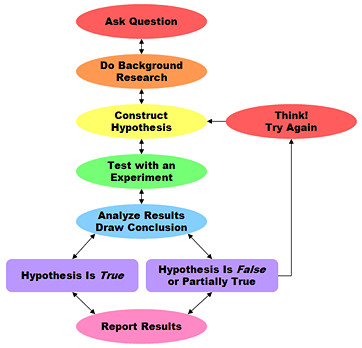In my previous post I was talking about the difficulty that scientists face to keep their research objective and unbiased. Luckily, smarter people than me have developed a basic set of concepts that help do that. All these concepts are mainly based on the Aristotelian laws of logic from the third century BC. Most of the ideas that define the scientific method nowadays are already described there. The scientific method is at the heart of science as a set of rules to make research as objective as possible. It is usually described in four basic steps.
Step 1: Observation and description of a phenomenon or group of phenomena.
Step 2: Formulation of a hypothesis to explain the phenomena.
Step 3: Use of the hypothesis to predict the existence of other phenomena, or to predict quantitatively the results of new observations.
Step 4: Performance of experimental tests of the predictions by several independent researchers and properly performed experiments.
Actually, people use these steps almost instinctively to predict cause and effect and adapt accordingly. For example, when you wake up in the morning, you look out of the window and see people on the street in cold weather clothing (Step 1, observation). Your hypothesis (Step 2) is that people are wearing warm clothes because it is cold outside (Step 3, prediction). To test your prediction you open a window or look at a thermometer (Step 4, Experiment). Usually the laymen abstain from enlisting independent researchers to do control experiments.
The scientific method has been refined over the centuries but the core of it is still untouched. The setup that is usually used as a checklist for adherence to the scientific method is the following:
- Define the question
- Gather information and resources (observe)
- Form hypothesis
- Perform experiment and collect data
- Analyze data
- Interpret data and draw conclusions serving as a starting point for new hypothesis
- Publish results
- Retest (frequently done by other scientists)
Notice point 6 which clearly shows that you normally refine your hypothesis based on the outcome of your first results. Most hypotheses defined by scientists continuously cycle between step 3 and 6 before they are ever published. The picture below describes the usual approach.
It is also important to note, that the scientific method doesn’t allow the absolute verification of a hypothesis. Einstein himself said: "No amount of experimentation can ever prove me right; a single experiment can prove me wrong." Especially physicists have a tendency to postulate an unknown factor, like the Higgs-Boson, to resolve issues with current theories. The current interest at the large colliders in
If the Higgs-Boson could not be experimentally proven in the predicted range, most theoretical models of physics would have to be reexamined. I think that makes it slightly more understandable why there is so much money going into this kind of research because entirely rethinking physics sounds like a huge headache to me.
You can easily test what I said about the instinctive use of the scientific method. Just watch yourself and observe how your brain works and you draw conclusions about your environment. Or ask people how they arrived at the conclusion that it won’t rain today. But don’t let them get away with: “It never rains when I have an umbrella with me.” Maybe you can disprove that to them using the scientific method.
Have a nice weekend and keep on thinking!
No comments:
Post a Comment